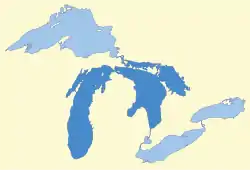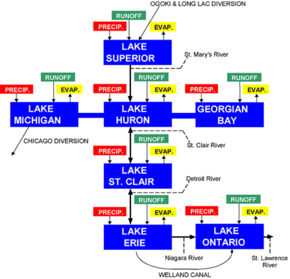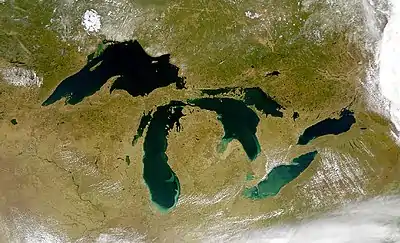Lake Michigan–Huron
Lake Michigan–Huron (also Huron–Michigan) is the name for the combined waters of Lake Michigan and Lake Huron, which are joined through the 5-mile-wide (8.0 km), 20-fathom-deep (120 ft; 37 m), open-water Straits of Mackinac. Huron and Michigan are hydrologically a single lake because the flow of water through the straits keeps their water levels in near-equilibrium. Although the flow is generally eastward, the water moves in either direction depending on local conditions. Combined, Lake Michigan–Huron is the largest freshwater lake by area in the world.[1][3][4][5] However, if Lake Huron and Lake Michigan are considered two separate lakes, Lake Superior is larger than either.
| Lake Michigan–Huron | |
|---|---|
 Lake Michigan–Huron lies in the center of the Great Lakes | |
 Lake Michigan–Huron | |
| Location | United States, Canada |
| Group | Great Lakes |
| Coordinates | 45.814°N 84.754°W |
| Lake type | Glacial |
| Primary inflows | St. Marys River |
| Primary outflows | St. Clair River |
| Basin countries | United States, Canada |
| Surface area | 45,300 sq mi (117,300 km2)[1] |
| Max. depth | 922 ft (281 m) |
| Water volume | 2,029 cu mi (8,460 km3) |
| Residence time | 100 years |
| Shore length1 | 3,250 mi (5,230 km) plus 2,215 mi (3,565 km) for islands[2] |
| Surface elevation | 577 ft (176 m) |
| Settlements | Milwaukee, Chicago, Sarnia, Owen Sound, Sheboygan, Port Huron, Traverse City |
| 1 Shore length is not a well-defined measure. | |
Geologic history
.JPG.webp)
During the last ice age, the sizes and connectivity of the two lake basins varied dramatically over time. Sequential advances and retreats of the Laurentian ice sheet repeatedly opened and dammed various possible outlets from the area, as well as providing dramatically varying amounts of meltwater to the system. Numerous proglacial lakes formed in various places and configurations as the ice sheet advanced and retreated.[6] At various times, what is now Michigan–Huron was clearly separated into two or more lakes, and at other times was part of a single, deeper lake.
Around 9,000 years BC, as the ice sheet retreated, the modern Lakes Huron, Michigan, and much of Superior, were a single lake known to geologists as Lake Algonquin. Ice sheets dammed Lake Algonquin to the northeast.[7] Before that, Lake Chicago occupied the southern tip of the Lake Michigan basin, at the southern end of the ice sheet. Lake Algonquin and Lake Chicago both drained south into the Mississippi River watershed.[8] Around 9,500 years ago, new pathways draining the system to the east were opened by the retreat of the ice, and proglacial Lake Stanley (precursor of Lake Huron) was separated from proglacial Lake Chippewa (precursor of Lake Michigan), with Lake Chippewa at a slightly higher level. They were connected by the now-submerged Mackinac Channel, which discharged into Lake Stanley over Mackinac Falls.[9][10] Ongoing warping of the land by post-glacial rebound due to the retreat of the glacial ice continued to modify the drainage structure of the region, allowing the reunification of all three basins (Superior, Michigan, and Huron) as the Nipissing Great Lakes. This arrangement was probably stable for more than 1,000 years, ending only when lake outlets other than the St. Clair River were cut off around 4,000 years ago. The current configuration of the lakes reflects the latest step in a long history of their post-glacial evolution.[6]
Bathymetry and hydrology

The connection between Lake Michigan and Lake Huron through the Straits of Mackinac is 5 miles (8 km) wide[11] and 120 feet (37 m) deep.[12] This depth compares with the maximum depths of 750 feet (229 m) in Lake Huron and 923 feet (281 m) in Lake Michigan. Although the Straits create a pronounced bottleneck in the contours of the shoreline and a major constriction in the local bathymetry, defining two distinct basins, they are still deep and wide enough to allow the free exchange of water between the two sides. Because of the link through the Straits, Lakes Michigan and Huron have the same mean water level (in June 2015 it was 580 feet (177 m)).[13]
The largest inflow to the system is the St. Mary's River from Lake Superior, and the main outflow is the St. Clair River toward Lake Erie; both lie in the Lake Huron basin.[14][3] The combined effects of seiches (resonant standing waves)[15] and of differing weather conditions (atmospheric pressure, wind)[14] over each basin act to drive water either way through the Straits on a variety of characteristic timescales, at amounts sometimes exceeding 75,000 m3/s (2,600,000 cu ft/s) for several hours in either direction.[15] However, the long-term average flow through the Straits is eastwards at 1,500–2,000 m3/s (53,000–71,000 cu ft/s), toward the outlet of the St. Clair River.[15] Flows into the system from Lake Superior are controlled by the bi-national Lake Superior Board of Control through the operation of locks and canals.[16]
Entity dispute
Because of the relatively small depth and width of the Straits of Mackinac compared to the water bodies it connects, the distinct basins that these occupy, and historical naming convention, Lake Michigan and Lake Huron are usually considered distinct. For instance, these two lakes are typically recorded as separate entries in lists of the largest lakes in the world by area and volume.[17][18][19][20][21] In the context of hydrology, however, the two are considered one body of water.[3][4] Because of the hydrologic connectivity through the Straits, some sources have considered the total area and volume of Lake Michigan–Huron when placing this system in a global or regional context.[22]
When Lake Michigan–Huron is treated as a single entity, it is the largest freshwater lake by surface area in the world.[1][22][23]
References
Notes
- "Great Lakes Map". Michigan Department of Environmental Quality. Retrieved 20 September 2012.
- Shorelines of the Great Lakes Archived 2015-04-05 at the Wayback Machine
- Egan, Dan (April 26, 2013). "International commission wants to look at engineering fix to boost Huron, Michigan levels". JSOnline. Milwaukee Journal Sentinel Inc. Retrieved 2013-04-28.
- "Lakes Michigan and Huron are considered to be one lake hydraulically because of their connection through the deep Straits of Mackinac." Great Lakes Environmental Research Laboratory, part of the National Oceanic and Atmospheric Administration. "Great Lakes Sensitivity to Climatic Forcing: Hydrological Models Archived 2010-08-08 at the Wayback Machine." NOAA, 2006.
- "Lakes Michigan and Huron are considered to be one lake, as they rise and fall together due to their union at the Straits of Mackinac." US Army Corps of Engineers, "Hydrological Components" Record Low Water Levels Expected on Lake Superior Archived 2008-10-15 at the Wayback Machine. August 2007. p.6
- Farrand, W. R. (1967, rev 1988) The Glacial Lakes around Michigan Geological Survey Division Michigan Department of Environmental Quality.
- "Great Lakes: Physiography". Encyclopædia Britannica. Encyclopædia Britannica, Inc. Retrieved September 17, 2012.
- Larson, Grahame; Schaetzl, R. (2001). "Origin and evolution of the Great Lakes" (PDF). Journal of Great Lakes Research. Internat. Assoc. Great Lakes Res. 27 (4): 518–546. doi:10.1016/S0380-1330(01)70665-X. Archived from the original (PDF) on 31 October 2008. Retrieved 21 September 2012.
- Schaetzl, Randall. "Mackinac Channel". Geography of Michigan and the Great Lakes Region. Michigan State University. Retrieved 18 September 2012.
- "Ancient Waterfall Discovered Off Mackinac Island's Shoreline". Mackinac Island Town Crier. Archived from the original on 19 July 2008. Retrieved 18 September 2012.
- Grady, Wayne (2007). The Great Lakes. Vancouver: Greystone Books and David Suzuki Foundation. pp. 42–43. ISBN 978-1-55365-197-0.
- "Michigan and Huron: One Lake or Two?" Pearson Education, Inc: Information Please Database, 2007.
- "Weekly Great Lakes Water Levels". United States Army Corps of Engineers. June 15, 2015. Retrieved 2015-06-22.
- Mortimer 2004, p. 59
- Saylor, James H. and Sloss, Peter W. (1976) Water Volume Transport and Oscillatory Current Flow through the Straits of Mackinac, Journal of Physical Oceanography, v. 6, p. 229-237
- Briscoe, Tony (July 13, 2018). "What happens when Lake Superior has too much water?". Chicago Tribune. Retrieved 2018-07-15.
- Likens, Gene E., ed. (2009). "Historical Estimates of Limnicity". Encyclopedia of inland waters (1st ed.). Amsterdam: Elsevier. ISBN 978-0-12-088462-9. Table 1: The world's lakes >2000 km2 in area, arranged in decreasing order of lake area. See also Lakes (Formation, Diversity, Distribution) Archived February 22, 2014, at the Wayback Machine
- Marsh, William M.; Kaufman, Martin M. (April 30, 2012). Physical geography: great systems and global environments. Cambridge: Cambridge University Press. p. 399, Table 16.2: Great lakes of the world by lake type. ISBN 978-0-521-76428-5.
- van der Leeden, Frits; Troise, Fred L.; Todd, David Keith, eds. (1991). The water encyclopedia (2nd ed.). Chelsea, Mich.: Lewis. pp. 198–200. ISBN 978-0-87371-120-3.
- "Large Lakes of the World". FactMonster. Pearson Education. Retrieved 14 September 2012.
- Rosenberg. Matt. "Largest lakes in the world". About.com. The New York Times Company. Retrieved September 13, 2012.
- David Lees in Canadian Geographic writes, "Contrary to popular belief, the largest lake in the world is not Lake Superior but mighty Lake Michigan–Huron, which is a single hydrological unit linked at the Straits of Mackinac. "Lees, David. "High and Dry" Canadian Geographic (May/June 2004) pp.94-108.
- Largest Lake in the World - Largest in the United States - GEOLOGY.COM
Further reading
- Burg, J. P. (1959). "Precipitation and the levels of Lake Michigan-Huron". Journal of Geophysical Research. 64 (10): 1591–1595. Bibcode:1959JGR....64.1591B. doi:10.1029/jz064i010p01591.
- De Geer, Sten (1928). The American manufacturing belt. Volume 4 of Geografiska annaler. Svenska Sällskapet för Antropologi och Geografi.
- Mortimer, Clifford H. (2004). Lake Michigan in motion: responses of an inland sea to weather, earth-spin, and human activities. Madison, Wis.: University of Wisconsin Press. pp. 59–78, 190–192, 300–309. ISBN 978-0-299-17834-5.
- Polderman, Nathan J.; Pryor, Sara C. (2004). "Linking Synoptic-scale Climate Phenomena to Lake-Level Variability in the Lake Michigan-Huron Basin". Journal of Great Lakes Research. 30 (3): 419–434. doi:10.1016/S0380-1330(04)70359-7.
- Schaetzl, Randall J.; Krist, Frank J.; Rindfleisch, Paul R.; Liebens, Johan; Williams, Thomas E. (2000). "Postglacial Landscape Evolution of Northeastern Lower Michigan, Interpreted from Soils and Sediments". Annals of the Association of American Geographers. 90 (3): 443–466. doi:10.1111/0004-5608.00204. S2CID 55689261.
- Schaetzl, Randall J.; Drzyzga, Scott A.; Weisenborn, Beth N.; Kincare, Kevin A.; Lepczyk, Xiomara C.; Shein, Karsten; Dowd, Cathryn M.; Linker, John (2002). "Measurement, Correlation, and Mapping of Glacial Lake Algonquin Shorelines in Northern Michigan". Annals of the Association of American Geographers. 92 (3): 399–415. doi:10.1111/1467-8306.00296. S2CID 56412226.
- Sellinger, Cynthia E.; Craig A. Two; E. Conrad Lamon; Song S. Qian (2008). "Recent water level declines in the Lake Michigan–Huron system". Environ. Sci. Technol. 42 (42): 367–373. doi:10.1021/es070664. PMID 18284132.
- Shelton, William A. (1912). "The Lakes-to-the-Gulf Deep Waterway: I". Journal of Political Economy. 20 (6): 541–573. doi:10.1086/252049. S2CID 154045181.
